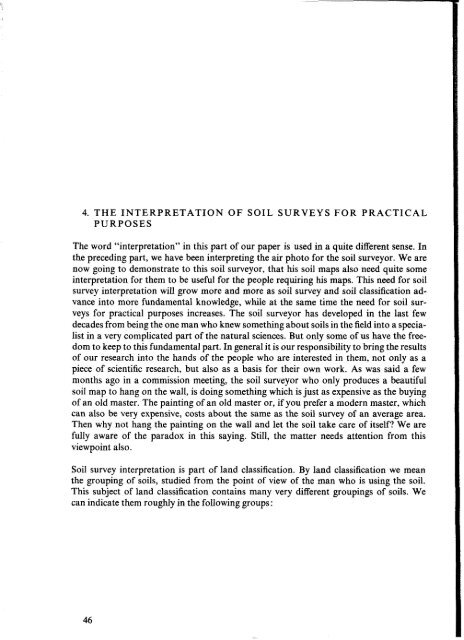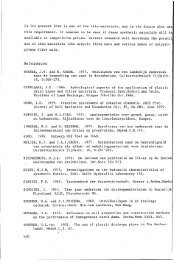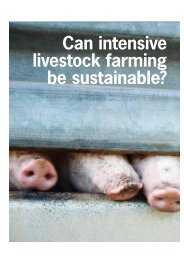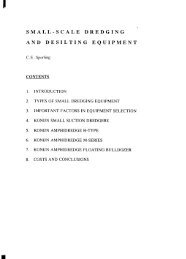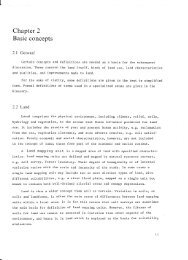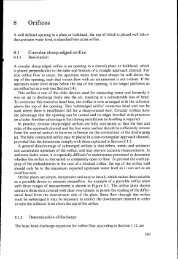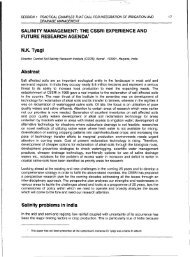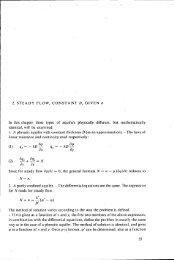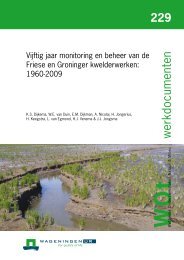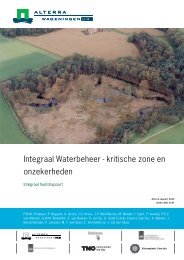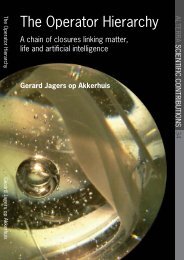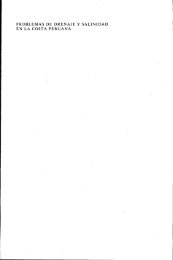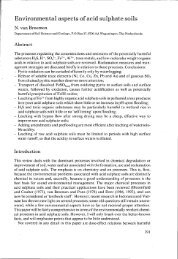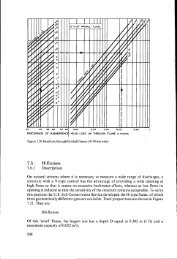4. THE INTERPRETATION OF SOIL SURVEYS FOR PRACTICAL ...
4. THE INTERPRETATION OF SOIL SURVEYS FOR PRACTICAL ...
4. THE INTERPRETATION OF SOIL SURVEYS FOR PRACTICAL ...
Create successful ePaper yourself
Turn your PDF publications into a flip-book with our unique Google optimized e-Paper software.
<strong>4.</strong> <strong>THE</strong> <strong>INTERPRETATION</strong> <strong>OF</strong> <strong>SOIL</strong> <strong>SURVEYS</strong> <strong>FOR</strong> <strong>PRACTICAL</strong>PURPOSESThe word “interpretation” in this part of our paper is used in a quite different sense. Inthe preceding part, we have been interpreting the air photo for the soil surveyor. We arenow going to demonstrate to this soil surveyor, that his soil maps also need quite someinterpretation for them to be useful for the people requiring his maps. This need for soilsurvey interpretation will grow more and more as soil survey and soil classification advanceinto more fundamental knowledge, while at the same time the need for soil surveysfor practical purposes increases. The soil surveyor has developed in the last fewdecades from being the one man who knew something about soils in the field into a specialistin a very complicated part of the natural sciences. But only some of us have the freedomto keep to this fundamental part. In general it is our responsibility to bring the resultsof our research into the hands of the people who are interested in them, not only as apiece of scientific research, but also as a basis for their own work. As was said a fewmonths ago in a commission meeting, the soil surveyor who only produces a beautifulsoil map to hang on the wall, is doing something which is just as expensive as the buyingof an old master. The painting of an old master or, if you prefer a modern master, whichcan also be very expensive, costs about the same as the soil survey of an average area.Then why not hang the painting on the wall and let the soil take care of itself? We arefully aware of the paradox in this saying. Still, the matter needs attention from thisviewpoint also.Soil survey interpretation is part of land classification. By land classification we meanthe grouping of soils, studied from the point of view of the man who is using the soil.This subject of land classification contains many very different groupings of soils. Wecan indicate them roughly in the following groups :46
Interpretation of soil survey1. Soil classification2. Soil quality classification3. Soil crop response classification<strong>4.</strong> Soil use classification5. Soil suitability classification6. Advisory land classification7. Administrative land classification.Soil classijìcation is the grouping of soils according to their inherent characteristics. It isthe fundamental grouping of the soils themselves from the pure view of natural scienceand is the foundation for all the other groupings mentioned.Soil quality classijìcation looks at the grouping of soils from a technical standpoint, that isthe technical qualities important for a certain use of the soils or for their improvement.This may be permeability, ploughability, erosion hazard, occurrence of an impermeablelayer, indications about hardpan, about drainage, about solidity, and many other of thesame kind. Sucha classification is extremely useful for the man who needs only a few indicationsof the soil map in a very definite sense. It is in general necessary for him to havethese indications. For instance a land consolidation engineer cannot be expected to knowall about soil science, so the soil scientist must help him to the essentials needed for thistechnical job. He may sometimes have to discuss these questions with the soil scientistbefore the latter can make a sufficiently useful classification for him.Soil crop response classijìcation gives the response of a crop on a certain soil type for acertain management procedure. This may be for instance the application of variousamounts of one or more artificial fertilizers. It may also be the response to drainage. Theeffect of growth of new varieties on various soils also falls in this category.Soil use classijication, or as it is more generally called, land use classijication, is the registeringof the present use of the soils. In this field we have the special World Land Use Surveyof which Prof. L. DUDLEY STAMP is the eminent leader. This land use classificationcan also be carried out on the basis of the use of the soil type or soil series, in which casewe call it soil use classification. This kind of classification is extremely useful becausethere often is an astonishing lack of knowledge about the actual way soils are used, notonly in so-called developing countries, but also in the middle of our Western so-calledcivilized and very intensively used countries. We consider the soil use classification, however,as an auxiliary classification. We do not think it possible to give accurate predictionson the potential use of soils by studying only this kind of data. For this it is necessary tohave more knowledge about the suitability of soils in general and especially, of course,about the particular soils themselves.47
We therefore think that soil suitability classification is the central part of soil survey interpretation.We consider soil quality classification and soil crop response classification asbeing part of this kind of soil groupings (cf KELLOGG, 1961). Soil suitability classificationindicates the suitability of a soil for a more or less specific use, or for an improvement ofthe soils. Therefore in the one case we speak of a suitability of use, whereas the other iscalled suitability of improvement. Fig. 7 indicates how suitability of use and suitability ofimprovement are connected. In this figure the possibility of a change of the profile, for instanceby deep-ploughing is also to be considered. This change of the profile consists of achange in the soil itself, so that in this case a new classification of the fundamental characteristicsof the soil must be made.WITH <strong>SOIL</strong> IMPROVEMENTPotential land use withirrigation and or dramgePotentrol land use withoutirrigation and OT droinage--fSoil- imwovementlNew soil map / IOrtginol soii mopFig. 7. Suitability of use and suitability of improvementt4WITHOUT <strong>SOIL</strong> IMPROVEMENTSuitability of useSuitability oftmmvement!%tential kmd use with specmimeasures Of irrigation andor drainagePotential land use withoutspecial measures ofirrigation and or droinoaeOriginal so11 typeSoil suitability classification gives the alternative possibilities and potentialities of thesoils without giving a conclusion as to the best way of using them. This is determined bythe advisory classification and the administrative classification or sometimes by also usingdata of economic land use classification. These three are out with the scope of soil surveyinterpretation, although they are part of land classification. The soil surveyor sometimeshas some function in advisory classification, but he should be very careful in this respect.The best use of the soil is not only a question of the soil itself, but of various social, politicaland economic considerations. Sometimes even religious considerations come to thefore, such as the possibility of keeping pigs in predominantly Islamic countries. The soilsurveyor must concern himself with soil suitability classification, but he should be verycareful not to set himself on the chair of the administrator.Soil suitability classification is based on various assumptions and is never an absolutesuitability. It is always considered under certain circumstances, but this is not always48
ctInterpretation of soil surveyssufficiently realized, even by those people who are working largely with this kind ofclassification. An example of this are the famous 8 classes of the U.S. Soil ConservationService. Until 1957 these classes were used without any official indication as to the assumptionson which they were based, and it was only around that time that they werepublished (KLINGEBIEL, 1958). Sometimes soil suitability classifications are made by soilsurveyors without their consulting anybody else. If the soil surveyor is himself a goodagronomist, and if no possibility of consulting other people exists, he must sometimesdo this as a first approximation. It is our experience that often this way of putting thequestion is the best way of entering into an effective discussion with other specialistsconcerned. But anyhow the soil surveyor must realize that it is also partly the farm economist,the agricultural engineer, the crop specialist and the soil fertility expert who areconcerned with suitability and who have a say in this matter. Therefore the soil suitabilityresearch, and also the putting into practice of this kind of work, must be organizedas soon as possible in teams of about 4 or 5 people, but I would never advise anybody tomake a team larger than 5 people.The soil surveyor must take the lead because he is the man who can handle his soil unitsas individuals and who also knows their variability. The other reason for which the soilsurveyor must take a large part of this soil suitability work is the immense profit he himselfgains from this, because he keeps in contact with the practical importance of a soilscience and the needs of those people who are using the soil surveys. In this way his questionsand his basic research are directed to the fundamental problems that have relationto reality. Some may think this a degradation of fundamental research but I feel that themain reason for the enormous amount of research in a science like physics is not first ofall a question of the advancement of pure science.The suitability of a soil for a crop is determined by the following 5 factors:1. gross yield in pounds per acre,2. cost of production of this yield in man hours, pounds of fertilizers, machinery, etc.,3. the yield hazard, caused by the sensitivity of a crop on a certain soil to the less favourableinfluences of climate and man,<strong>4.</strong> the quality of the product,5. the soil pattern.The scope of this paper does not permit us to give a full description of these factors. Werefer to previous publications (VINK, 1956, 1958, 1960).The quantitative working of the above factors is determined by the general economic circumstances,technical advance, and management level. The management level is verywell described in the Soil Survey Manual (Soil Survey Staff, 1951) and by KELLOGG (1950).The definition of economic and technical level should in general be done in co-operationwith specialists on these fields.49
APPENDIXAERIAL PHOTOGRAPHY <strong>FOR</strong> <strong>SOIL</strong> SURVEY PROJECTSGENERAL TENTATIVE OUTLINE, SUBJECT TO VARIATIONS ; BASED ON DRAFT SPECIFICATIONSMADE BY F. L. CORTEN AND A. P. A. VINKCamera typeWide-angle camera (i.e. f = 11 ... 12 cm for 18 x 18 cm image size; f = 15 cm (6”) for24 x 24 cm (9” x 9”) image size) if the terrain elevations per model are not more than10 % ... 15 % of the flying height.Normal-angle camera (i.e. f = 20 cm for I8 x 18 cm immage size; f = 9” for 9” x 9”image size) if terrain elevations more than 15 % of the flying height do occur in one model.Either wide-angle or normal angle where terrain elevations are of the order of 10%H... 15% H.Flight planAccording to the boundaries of the main physiographic units but as far as possible eastwestfight lines. East-west flight lines are certainly recommended if no definite preferenceaccording to physiography can be shown. Photo scale preferably 1 : 20.000 with respect tomean datum. (Photo scale alternatively between 1 : 25.000 and maximum 1 :15.000). Timeof flight: preferably in such a season that the significant soil conditions and the differencesin vegetation types, show up as far as possible in the photographs with maximum tonalcontrast.In the case of reconnaissance soil surveys smaller scales, up to approximately 1 : 70.000may be used. In this case the use of a super-wide-angle camera should be considered.East-west flight lines are recommended.50
Survey navigationVertical photography. Average tilt values not more than 1"; maximum tilt = 3". Longitudinaloverlap average between 57 % and 60 %. Maximum 65 % and minimum 55 %.Side lap average 15 % maximum 25 % and minimum 10 %.Crab shall be corrected for, up to a negligible degree, in any case not more than 10 mm onany point of the photograph.PhotographyAtmospheric conditions shall be such that no appreciable haze is present; the resultingnegatives shall show some shadow detail, shall show detail contrast and shall be clear.No more than 2 % of area cloud plus cloud shadow shall occur in any photograph. Developmentshall be carried to gamma = 1.2 approximately. Exposure shall be such that theminimum negative density is :Dmin = Dfog + 0.2 D + 0.1 DBlurring and unsharpness due to image movement shall be completely absent.DeliveryOne set (or more if desired) of glossy contact prints plus one set (or more) of semi-mattcontact prints shall be delivered. All photographs and flight lines shall be numbered. Anindex map shall be delivered, preferably a topographic map 1 : 25,000 (or 1 : 20,000) showingall photo- and flight-line numbers and principal points' positions. For small scale soilsurveys, index-mosaics on scale 1 : 100,OOO or 1 : 200,000 may be very useful. For sampleareas a set of alternate enlargements (1 : 10,000 or 1 : 5,000) of excellent quality on semimattpaper shall be delivered. The time of delivery of these enlargements should bewithin one month after the areas and photonumbers have been indicated by the seniorsoil surveyor in charge of the project. Semi-controlled mosaics in approximated photoscale(1 : 20,000 preferably) shall be compiled; preferably two (or more?) copies of eachsheet on semi-matt paper shall be delivered. In some cases, uncontrolled mosaics aresufficient.They may even be preferable if the time of delivery can be markedly put forward. Thekind of control (or lack of control) should however always be indicated on the mosaicssheets.51
LITERATUREBURINGH, P., 1960: Soils and soil conditions in Iraq, Baghdad.BURINGH, P., 1960: Photo-interpretation in the I.T.C. Soil Section, I.T.C. Publication B2, Delft.BURINGH, P., 1960: The applications of aerial photography in soil surveys, in: Manual of photographicinterpretation, Washington (D.C.), p. 633 seq.BURINGH, P., STEUR, G. G. L. and VINK, A. P. A., 1962: Some techniques and methods of soil survey inthe Netherlands (in preparation).DURY, G. H., 1960: The face of the earth, Pelican books, no. A 447.GIBBS, H. S., 1959: Soil classification for the user. Soil bureau publication, no. 196, New Zealand.GOOSEN, D., 1961 : A study of geomorphology and soils in the middle Magdalena Valley, Colombia.1.T.C.-Publication B9, Delft.KELLOGG, C. E., 1950: Tropical soils, Trans. IVth Intem. Congr. Soil Sci., Vol. 1,266-276.KELLOGG, C. E., 1955: Soil surveys in modem farming, Journ. Soil and Water Conservation, Vol. 10,271-277.KELLOGG, C. E., 1961 : Soil interpretation in the soil survey, U.S.D.A., Soil Conservation Service Statement,Washington (D.C.).MEESTER, T. DE, 1961 : The application of airphoto analysis in a detailed soil survey in Tanganyika, I.T.C.Publication B 10, Delft.MIKHAILOV, V. Y., 1961 : The use of colour sensitive films in aerial photography in U.S.S.R., Photogrammetria,17,99-10<strong>4.</strong>MOON, J. W., LIGON, W. S. and HENDERSON, J. R., 1949: Soil classification and soil maps: original fieldsurveys. Soil Sci., 67,169-175.NYGARD, I. J. and HOLE, F. D., 1949: Soil classification and soil maps: units of mapping. Soil Sci. 67,163-168.ORVEDAL, A. C., BALDWIN, M. and VESSEL, A. J., 1949: Soil classification and soil maps: compiled maps.Soil Sci. 67, 177-181.PANNEKOEK, A. J., 1961 : Beschouwingen over generalisatie in de kartografie, I & 11. Tijdschrift Kon. Ned.Aardr. Gen., 78,203-210,311-329.PLATONENKO, M. A., 1960: Accuracy in mapping soils from aerial photographs. Translation. Soviet SoilScience, 1960 no. 1 (May 1961).REYNDERS, J. J., 1961 : Soil survey in Netherlands New Guinea. Boor en Spade (“Auger and Spade”), XI,77-81, Wageningen.RIECKEN, F. F., and SMITH, G. D., 1949: Lower categories of soil classification: family, series, type andphase. Soil Sci. 67,107-115.SCHELLING, J., 1961 : The high forest soils of the Central Netherlands. Bodemkundige Studies, 5. Stichtingvoor Bodemkartering, Bennekom.52
LISCHERMERHORN, W., 1961 : De betekenis van luchtkartering voor de huidige wereldontwikkeling. Kon.Ned. Acad. v. Wetenschappen, Afd. Natuurkunde 70, no. 5.<strong>SOIL</strong> SURVEY STAFF, 1951 : Soil Survey Manual, U.S.D.A., Handbook 18, Washington (D.C.).<strong>SOIL</strong> SURVEY STAFF, 1960: Soil Classification (7th approximation), U.S.D.A., Washington (D.C.).STEUR, G. G. L., 1961 : Methods of soil surveying in use at the Netherlands Soil Survey Institute. Booren Spade (“Auger and Spade”), XI,59-77, Wageningen, 1961 ..STEUR, G. G. L., 1961 : De bodemkaart van Nederland op kaartbladen. Landbouwk. Tijdschrift.TRANSACTIONS <strong>OF</strong> <strong>THE</strong> SYMPOSIUM ON PHOTO <strong>INTERPRETATION</strong>, Delft, The Netherlands, September 1962.International Archives of Photogrammetry, XIV.VEENENBOS, J. S., 1957: Methods and costs of soil and land classification surveys. African Soils, Vol. IV,122-135.VERBOOM, W. C., 1961 : Planned rural development in Northern Rhodesia. I.T.C. Publication B12/13,Delft.VINK, A. P. A., 1956: Applications of soil survey, 11. Agriculture Trans., VIth Int. Congr. Soil Sci., Paris,Vol. D, 639-64<strong>4.</strong>VINK, A. P. A., 1960: Quantitative aspects of land classification. Trans. VIIth. Int. Congress Soil Sci.,Vol. IV, 371-378.VINK, A. P. A., 1961 : De luchtfoto in verband met de landbouwkundige ontwikkeling van tropische ensubtropische gebieden. Tijdschrift Kon. Ned. Aardr. Gen. 78, 135-145.VINK, A. P. A., 1962: Practical soil surveys and their interpretation for practical purposes, 1.T.C.-Publication B 16, Delft.53
LIST <strong>OF</strong> ILLUSTRATIONSpagePhotos out of text:- Example of a soil map made by photo interpretation and some field work: Rutba, Iraq')- Maienfeld, Switzerland')- Paricutin, Mexico')Figures in text:16 Fig. 1. The relationship between air photo interpretation and soil survey production17 Fig. 2. Five different methods of soil survey18 Fig. 3. Diagram of elements of air photo interpretation20,'21 Fig. <strong>4.</strong> Comparison of a photo interpretation map (a) and of the soil map of the same area (b)established during the field check (scale 1 :25.OOO). I.T.C. experimental area, Luxemburg39 Fig. 5. The basic mapping unit (approx. 5.4 x enlarged)44 Fig. 6. Gradual transitions of soils48 Fig. 7. Suitability of use and suitability of improvementPhotosraahs provided by:'1 Wild, Heerbrugg, Limited. Heerbrugg, Switzerland ; Topographical Survey of Switzerland, Wabern. Berne.55


